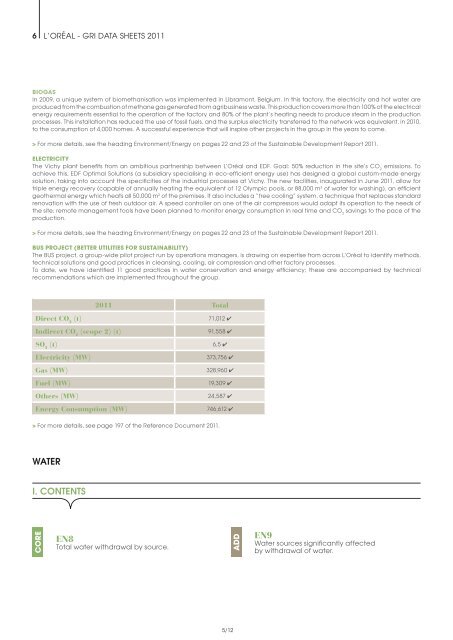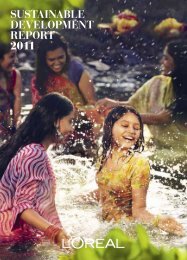Organizational Strategy - Sustainable Development - L'Oréal
Organizational Strategy - Sustainable Development - L'Oréal
Organizational Strategy - Sustainable Development - L'Oréal
You also want an ePaper? Increase the reach of your titles
YUMPU automatically turns print PDFs into web optimized ePapers that Google loves.
6 L’oréaL - GrI DaTa SHEETS 2011<br />
BIOGAS<br />
In 2009, a unique system of biomethanisation was implemented in Libramont, Belgium. In this factory, the electricity and hot water are<br />
produced from the combustion of methane gas generated from agribusiness waste. This production covers more than 100% of the electrical<br />
energy requirements essential to the operation of the factory and 80% of the plant’s heating needs to produce steam in the production<br />
processes. This installation has reduced the use of fossil fuels, and the surplus electricity transferred to the network was equivalent, in 2010,<br />
to the consumption of 4,000 homes. a successful experience that will inspire other projects in the group in the years to come.<br />
> For more details, see the heading Environment/Energy on pages 22 and 23 of the <strong>Sustainable</strong> <strong>Development</strong> report 2011.<br />
ELECTRICITY<br />
The Vichy plant benefits from an ambitious partnership between L’oréal and EDF. Goal: 50% reduction in the site’s Co 2 emissions. To<br />
achieve this, EDF optimal Solutions (a subsidiary specialising in eco-efficient energy use) has designed a global custom-made energy<br />
solution, taking into account the specificities of the industrial processes at Vichy. The new facilities, inaugurated in June 2011, allow for<br />
triple energy recovery (capable of annually heating the equivalent of 12 olympic pools, or 88,000 m 3 of water for washing), an efficient<br />
geothermal energy which heats all 50,000 m 2 of the premises. It also includes a “free cooling” system, a technique that replaces standard<br />
renovation with the use of fresh outdoor air. a speed controller on one of the air compressors would adapt its operation to the needs of<br />
the site; remote management tools have been planned to monitor energy consumption in real time and Co 2 savings to the pace of the<br />
production.<br />
> For more details, see the heading Environment/Energy on pages 22 and 23 of the <strong>Sustainable</strong> <strong>Development</strong> report 2011.<br />
BUS PROJECT (BETTER UTILITIES FOR SUSTAINABILITY)<br />
The BUS project, a group-wide pilot project run by operations managers, is drawing on expertise from across L’oréal to identify methods,<br />
technical solutions and good practices in cleansing, cooling, air compression and other factory processes.<br />
To date, we have identified 11 good practices in water conservation and energy efficiency; these are accompanied by technical<br />
recommendations which are implemented throughout the group.<br />
> For more details, see page 197 of the reference Document 2011.<br />
WATER<br />
2011 Total<br />
Direct CO 2 (t) 71,012 4<br />
Indirect CO 2 (scope 2) (t) 91,558 4<br />
SO 2 (t) 6,5 4<br />
Electricity (MW) 373,756 4<br />
Gas (MW) 328,960 4<br />
Fuel (MW) 19,309 4<br />
Others (MW) 24,587 4<br />
Energy Consumption (MW) 746,612 4<br />
I. CONTENTS<br />
CORE<br />
EN8<br />
Total water withdrawal by source.<br />
5/12<br />
ADD<br />
EN9<br />
Water sources significantly affected<br />
by withdrawal of water.






